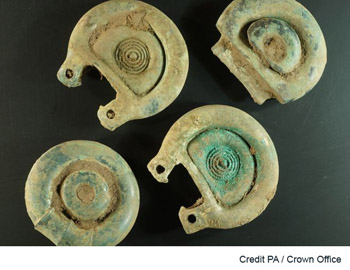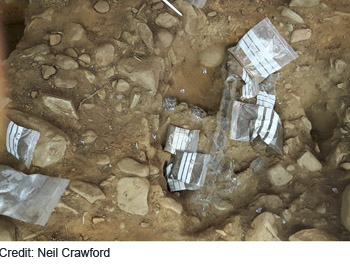
- Tab 1
News
Bronze Age hoard discovered near Peebles
 On June the 21st an amateur metal detectorist, Mariusz Stepien, was prospecting with friends on farmland west of Peebles when he uncovered a bronze object buried at a depth of around half a metre. Immediately, realising that he had discovered something of significance, Mariusz notified the Treasure Trove Unit. Archaeologists, led by Dr. Frazer Hunter from The National Museum of Scotland, spent the next three weeks excavating the site.
On June the 21st an amateur metal detectorist, Mariusz Stepien, was prospecting with friends on farmland west of Peebles when he uncovered a bronze object buried at a depth of around half a metre. Immediately, realising that he had discovered something of significance, Mariusz notified the Treasure Trove Unit. Archaeologists, led by Dr. Frazer Hunter from The National Museum of Scotland, spent the next three weeks excavating the site.
Stephen Scott and Neil Crawford of Peebles Archaeological Society were kindly invited to participate by carrying out a topographic survey to locate the excavation within its landscape context.
 This hoard is only the second of its type to be unearthed in Scotland. The first was discovered just a few miles upstream on the river Tweed at Horsehope Craig in 1864. However, this recent find is especially significant as unique preservational conditions at the site have given archaeologists a rare opportunity to study a collection of bronze artifacts, including a bronze age sword still in its scabbard and several items that make up a finely decorated horse harness. The archaeologists also recovered a decorative “rattle pendant” which is the first to be discovered in Scotland and only the third to be found in the UK.
This hoard is only the second of its type to be unearthed in Scotland. The first was discovered just a few miles upstream on the river Tweed at Horsehope Craig in 1864. However, this recent find is especially significant as unique preservational conditions at the site have given archaeologists a rare opportunity to study a collection of bronze artifacts, including a bronze age sword still in its scabbard and several items that make up a finely decorated horse harness. The archaeologists also recovered a decorative “rattle pendant” which is the first to be discovered in Scotland and only the third to be found in the UK.
In general, organic materials are not well preserved in non-waterlogged Scottish contexts as the soils are acidic. What makes this excavation special is the fact that diagenetic alteration of the soils in the immediate vicinity of the bronze artifacts has created a unique local environment that is favourable to the preservation of delicate organic materials, such as those that make up the sword scabbard and harness straps. Consequently, it is hoped that the archaeologists may be able to identify the materials from which these items were made and study their method of construction. It may even be possible to reconstruct how the component parts of a three thousand year old harness would have been assembled and placed on a living horse.
Although the main bronze artifacts were initially exposed in the field, it was subsequently decided to ‘block lift’ the finds so that further work on the delicate organic materials could be carried out under controlled conditions. This study will therefore proceed over the coming months at the National Museum of Scotland.
Furthermore, before the site was backfilled, excavation revealed that the hoard was buried in close proximity to the foundations of two Bronze Age round houses. Consequently, the excavators intend to return in the future to further explore the wider archaeological context of this important and interesting site. Hopefully, PAS members will be invited to assist with this important and interesting work. Perhaps a member of the excavation team may also be persuaded to come to Peebles to talk to PAS members about the hoard – Covid restrictions permitting of course!